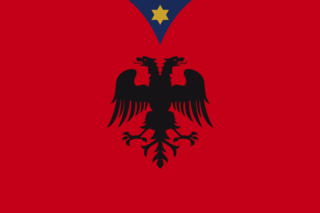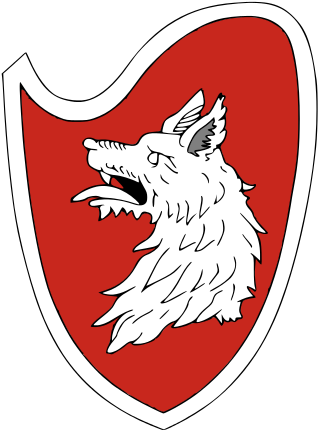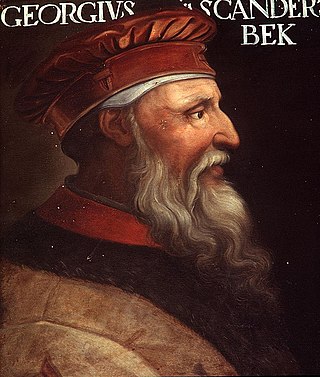
The League of Lezhë, also commonly referred to as the Albanian League, was a military and diplomatic alliance of the Albanian aristocracy, created in the city of Lezhë on 2 March 1444. The League of Lezhë is considered the first unified independent Albanian country in the Medieval age, with Skanderbeg as leader of the regional Albanian chieftains and nobles united against the Ottoman Empire. Skanderbeg was proclaimed "Chief of the League of the Albanian People," while Skanderbeg always signed himself as "DominusAlbaniae".

The siege of Berat took place in July 1455 when the Albanian army of Skanderbeg attempted to capture the fortress in the Albanian city of Berat, which was held by Ottoman forces. The attempt resulted in a failure when an Ottoman relief army arrived and routed the besieging forces.

Gjergj Arianiti (1383–1462) was an Albanian feudal lord who led several successful campaigns against the Ottoman Empire. He was the father of Donika, Skanderbeg's wife, as well as the grand-uncle of Moisi Arianit Golemi. Gjergj Arianiti was Skanderbeg's ally within the League of Lezhë before abandoning the alliance after the defeat in Berat in 1450. He later returned. Robert Elsie emphasizes that Arianiti was often Skanderbeg's rival. He allied with the Kingdom of Naples in 1446, left his alliance with Skanderbeg by 1449 and allied with Venice in 1456. However, his daughter married Skanderbeg and he remained officially part of the League of Lezhe, continuing to fight Ottomans successfully up to his death in 1462.

Hamza Kastrioti was a 15th-century Albanian nobleman and the nephew of Gjergj Kastrioti Skanderbeg. Probably born in Ottoman territory, after the death of his father Stanisha he was raised by Skanderbeg, who took him in his military expeditions. After the Battle of Nish he deserted Ottoman troops together with his uncle Skanderbeg, converted to Christianity and changed his name to Branilo. He supported Skanderbeg's uprising and was the vice captain of Skanderbeg's troops when they captured Krujë in 1443.

The Battle of Torvioll, also known as the Battle of Lower Dibra, was fought on 29 June 1444 on the Plain of Torvioll, in what is now Albania. Gjergj Kastrioti Skanderbeg was an Ottoman Albanian general who decided to return to his homeland and take the reins of a new Albanian league against the Ottoman Empire. He and 300 other Albanians who fought in the Battle of Niš deserted the Ottoman Army and made their way to Krujë, which quickly fell due to subversion. He then formed the League of Lezhë, a confederation of Albanian princes united in war against the Ottoman Empire. Realising the threat, Murad II sent one of his most experienced generals, Ali Pasha, to crush the new state with a force of 25,000 men.

The Principality of Kastrioti was one of the Albanian principalities during the Late Middle Ages. It was formed by Pal Kastrioti who ruled it until 1407, after which his son, Gjon Kastrioti ruled until his death in 1437 and then ruled by the national hero of Albania, Skanderbeg.

The Albanian–Venetian War of 1447–48 was waged between Venetian and Ottoman forces against the Albanians under George Kastrioti Skanderbeg. The war was the result of a dispute between the Republic and the Dukagjini family over the possession of the Dagnum fortress. Skanderbeg, then ally of the Dukagjini family, moved against several Venetian held towns along the Albanian coastline, in order to pressure the Venetians into restoring Dagnum. In response, the Republic sent a local force to relieve the besieged fortress of Dagnum, and urged the Ottoman Empire to send an expeditionary force into Albania. At that time the Ottomans were already besieging the fortress of Svetigrad, stretching Skanderbeg's efforts thin.
Skanderbeg's Macedonian campaign was a preemptive campaign into the Ottoman Empire in Macedonia by Skanderbeg to defeat three Ottoman armies which had been prepared for the joint-invasion of Albania. From 1461 to 1462, Skanderbeg campaigned in Italy to protect his ally, Ferdinand I, from being overrun by the Angevin dynasty which claimed the Kingdom of Naples. Before setting out for Italy, Skanderbeg forged a truce with Sultan Mehmed II. Upon returning to Albania after securing Ferdinand, the Venetians became hostile to Skanderbeg and a sort of undeclared war took place. Mehmed saw an opportunity to attack Skanderbeg and sent three armies in one year. All three were defeated by Skanderbeg, however, in August 1462.

Voisava was a noblewoman and wife of Gjon Kastrioti, an Albanian feudal lord from the House of Kastrioti. They had nine children together, one of whom was the Albanian national hero Gjergj Kastrioti, better known as Skanderbeg.
Ajdin Muzaka was the brother in law of Gjergj Kastrioti (Skanderbeg) and one of his commanders. He was converted to Islam and served in Ottoman army before joining Skanderbeg's rebellion. He was the commander of the central group in the Battle of Torvioll and he played a crucial role in the Albanian victory. He was wounded in that battle and died soon afterwards. He was known for his extreme courage and was the first high-rank Albanian commander who died in Skanderbeg's battles against Ottoman forces.

Lekë Zaharia Altisferi was an Albanian nobleman from the Zaharia family. He was the only son of his father Koja Zaharia and mother Bosa Dukagjini, who also had one daughter, Bolia, who named her son Koja after her father.
Giammaria Biemmi was an Italian priest who published a work on Skanderbeg titled Istoria di Giorgio Castrioto Scanderbeg-Begh. His work was published in Brescia, Italy in 1742.
Lekë Dushmani was an Albanian nobleman and one of the founding members of League of Lezhë, formed on 2 March 1444.
Pal Dukagjini was an Albanian nobleman, a member of the Dukagjini family. He and his kinsman Nicholas Dukagjini were initially subjects of Lekë Zaharia, a Venetian vassal who had possessions around Shkoder. Nicholas murdered Lekë, and the Dukagjini continued to rule over their villages under Venetian vassalage. Pal and Nicholas were part of the League of Lezhë, a military alliance that sought liberation of Albania from the Ottoman Empire, founded by the powerful Skanderbeg. In 1454, the Dukagjini accepted vassalage of Alfonso V of Aragon, as other chieftains had done three years earlier. Pal later abandoned Skanderbeg's army and deserted to the Ottomans.
Gojko Balšić or Gojko Balsha and his brothers George Strez and John were the lords of Misia, a coastal area from the White Drin towards the Adriatic. The brothers were members of the house of Balšić, which earlier held the Lordship of Zeta. They participated in founding the League of Lezhë, an alliance led by their maternal uncle Gjergj Kastrioti Skanderbeg. Gojko supported Skanderbeg until the latter's death in 1468, and then continued to fight against the Ottomans within Venetian forces.

George Strez Balšić or Gjergj Strez Balsha and his brothers Gojko and Ivan were the lords of Misia, a coastal area from the White Drin towards the Adriatic. The brothers were members of the Balšić noble family, which had earlier held Zeta. They participated in founding of the League of Lezhë, an alliance led by their maternal uncle Skanderbeg. George later betrayed Skanderbeg, by selling a domain to the Ottomans, while his two brothers continued to support Skanderbeg until his death and then continued to fight for the Venetian forces.
Ivan Strez Balšić or John Balsha fl. 1444–1469) and his brothers George Strez and Gojko Balšić were the lords of Misia, a coastal area from the White Drin towards the Adriatic. The brothers were members of the Balšić family, which earlier held Zeta, but had now placed itself among the nobility in Albania. They participated in founding of the League of Lezhë, an alliance led by their maternal uncle Skanderbeg. Ivan and Gojko supported Skanderbeg until he died in 1468 and then continued to fight against Ottomans together with Venetian forces. After Skanderbeg's death Venice installed Ivan Strez Balšić as Skanderbeg's successor.
Andrea II Thopia was a 15th century Albanian nobleman whose domains included the territory of Scuria. He was a member of the Thopia family and one of the founders of the League of Lezhë.

Skanderbeg's rebellion was an almost 25-year long anti-Ottoman rebellion led by the Albanian military commander Skanderbeg in what is today Albania and its neighboring countries. It was a rare successful instance of resistance by Christians during the 15th century and through his leadership led Albanians in guerrilla warfare against the Ottomans.

Mamica Kastrioti was a 15th century Albanian princess from the House of Kastrioti. She is best known as the younger sister of the Albanian hero Skanderbeg.













